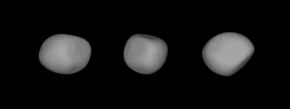 A three-dimensional model of 54 Alexandra based on its light curve | |
| Discovery[1] | |
|---|---|
| Discovered by | H. Goldschmidt |
| Discovery date | 10 September 1858 |
| Designations | |
| (54) Alexandra | |
| Pronunciation | /ˌælɪɡˈzændrə, -ˈzɑːn-/ AL-ig-ZA(H)N-drə[2] |
Named after | Alexander von Humboldt (German explorer) |
| Main belt | |
| Adjectives | Alexandrian |
| Orbital characteristics | |
| Epoch December 31, 2006 (JD 2454100.5) | |
| Aphelion | 485.483 Gm (3.245 AU) |
| Perihelion | 326.043 Gm (2.179 AU) |
| 405.763 Gm (2.712 AU) | |
| Eccentricity | 0.196 |
| 1,631.620 d (4.47 a) | |
| 103.809° | |
| Inclination | 11.804° |
| 313.446° | |
| 345.594° | |
| Physical characteristics | |
| Dimensions | 160 × 135 km (± 1 km) |
| 154.137 km[1] | |
| Mass | (6.16±3.50)×1018 kg[3] |
Mean density | 3.50±2.11 g/cm3[3] |
| 18.14 h[4] | |
Pole ecliptic latitude | 155°±4°[5] |
Pole ecliptic longitude | 17°±3°[5] |
| 0.056[1][6] | |
| Tholen = C [1] SMASS = C [1] | |
| 7.66[1] | |
54 Alexandra is a carbonaceous asteroid from the intermediate asteroid belt, approximately 155 kilometers in diameter. It was discovered by German-French astronomer Hermann Goldschmidt on 10 September 1858, and named after the German explorer Alexander von Humboldt; it was the first asteroid to be named after a male.[7]
- ^ a b c d e f Cite error: The named reference
jpldatawas invoked but never defined (see the help page). - ^ "Alexandra". Lexico UK English Dictionary. Oxford University Press. Archived from the original on 22 March 2020.
"Alexandra". Dictionary.com Unabridged (Online). n.d. - ^ a b Cite error: The named reference
Carry2012was invoked but never defined (see the help page). - ^ Cite error: The named reference
Belskaya1993was invoked but never defined (see the help page). - ^ a b Cite error: The named reference
Hanus2017was invoked but never defined (see the help page). - ^ "Asteroid Data Sets". Archived from the original on 17 December 2009. Retrieved 12 January 2007.
- ^ Cite error: The named reference
Schmadel2003was invoked but never defined (see the help page).